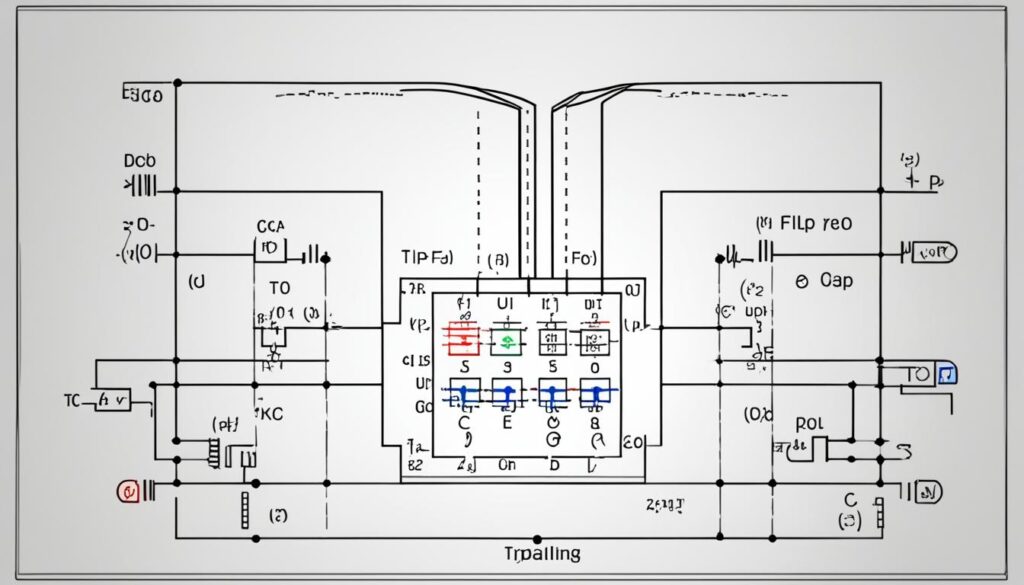Welcome to the world of digital circuits, where complex systems are built upon the foundation of fundamental building blocks. One such crucial component is the T Flip-Flop. In this article, we will explore the inner workings and applications of T Flip-Flops within digital circuits.
As technology continues to advance at a rapid pace, the need for efficient and reliable digital circuits becomes increasingly important. T Flip-Flops play a pivotal role in storage, timing, and binary counting applications, making them a fundamental element of modern digital systems.
Throughout this article, we will delve into the basics of T Flip-Flops, understanding their construction and operation modes. We will also explore their applications, ranging from data storage to frequency division and toggle operations.
Additionally, we will analyze the crucial timing aspects of T Flip-Flops, including setup and hold times, propagation and contamination delays. By gaining a comprehensive understanding of these timing considerations, engineers can design digital systems that meet performance requirements and mitigate potential issues.
In conclusion, the knowledge and application of T Flip-Flops in digital circuits are essential for engineers striving to create efficient and robust systems. Join us as we dive into the realm of T Flip-Flops and discover their versatile capabilities within digital circuits.
Table of Contents
Understanding T Flip-Flop Basics
In this section, we will provide a thorough understanding of the basic concepts and principles behind the T Flip-Flop. The T Flip-Flop is an essential component in digital circuits, allowing for the storage and manipulation of binary data. It operates based on the toggling action of the input signal, which results in different outputs depending on the current state of the flip-flop.
The T Flip-Flop is constructed using various logic gates, such as AND and XOR gates, which are interconnected in a specific configuration. These gates work together to create a circuit that can store and change the state of the flip-flop in response to the input signal.
One of the key features that distinguishes the T Flip-Flop from other types of flip-flops is its ability to toggle between states. When the input signal (T input) is high, the output of the flip-flop switches to the opposite state. In contrast, when the input signal is low, the flip-flop maintains its current state.
There are two main operation modes of the T Flip-Flop: the asynchronous set and reset mode, and the synchronous toggle mode. In the set and reset mode, the flip-flop has separate inputs (S and R) that can be used to force the output to a specific state. In the toggle mode, the flip-flop toggles its output based on the input signal.
Construction of a T Flip-Flop
To better understand the construction of a T Flip-Flop, let’s take a look at the following table:
| T Input | Previous State (Q) | Next State (Q’) |
|---|---|---|
| 0 | 0 | 0 |
| 1 | 0 | 1 |
| 0 | 1 | 1 |
| 1 | 1 | 0 |
From the table, we can observe that when the input signal (T) is low (0), the flip-flop maintains its previous state. On the other hand, when the input signal is high (1), the flip-flop toggles its state – if the previous state was 0, it becomes 1, and vice versa.
The T Flip-Flop is widely used in digital circuits due to its versatility and simplicity. It can be used for various applications, such as memory storage, frequency division, and toggle operations. Additionally, it plays a crucial role in synchronous and asynchronous systems, enabling precise timing and synchronization between different components.
T Flip-Flop Applications
In this section, we will explore the various applications of T Flip-Flops in digital circuits. T Flip-Flops are fundamental building blocks that play a crucial role in diverse electronic systems, enabling efficient data storage, accurate timing control, and effective binary counting. Let’s delve into some of the key applications:
Data Storage
T Flip-Flops are commonly used for data storage purposes. By utilizing its toggling functionality, the T Flip-Flop can store a single bit of data and retain it until a new signal triggers a change. This makes them ideal for storing and reading information in memory systems, registers, and flip-flop-based storage devices.
Frequency Division
Another significant application of T Flip-Flops lies in frequency division circuits. By connecting multiple T Flip-Flops in a cascading fashion, it is possible to achieve frequency division by powers of two. This technique is extensively used in clock dividers, frequency synthesizers, and digital frequency counters.
Toggle Operations
The toggle capability of T Flip-Flops finds valuable applications in various scenarios. It allows for alternating the state of a circuit or signal by simply triggering the T Flip-Flop. Toggle operations are employed in sequential circuits, pulse generation, digital timers, and programmable logic controllers.
Synchronous and Asynchronous Systems
T Flip-Flops have significant importance in both synchronous and asynchronous digital systems. In synchronous systems, T Flip-Flops are synchronized with a shared clock signal to ensure accurate timing and data propagation. Asynchronous systems, on the other hand, utilize T Flip-Flops to handle requests and process data independently, providing flexibility and efficiency in asynchronous communication protocols and event-driven applications.
By harnessing the diverse applications of T Flip-Flops, engineers can design robust and sophisticated digital circuits that meet various functional requirements. The versatility and reliability of these devices make them invaluable tools in modern electronic designs.
T Flip-Flop Timing Analysis
Timing plays a crucial role in the functioning of digital circuits. In this section, we will delve into the timing aspects of T Flip-Flops, a fundamental component in designing digital systems. Understanding the timing characteristics of T Flip-Flops is essential for ensuring accurate data storage, reliable signal propagation, and efficient circuit performance.
One key aspect of T Flip-Flop timing analysis is the determination of the setup and hold times. The setup time refers to the minimum duration that the input signal must be stable before the rising edge of the clock to ensure correct data capture. On the other hand, the hold time specifies the minimum duration that the input signal must remain stable after the rising edge of the clock for reliable data retention.
Propagation and contamination delays are critical parameters to consider when analyzing T Flip-Flop timing. The propagation delay represents the time taken for the output of the flip-flop to change after the input has changed. In contrast, the contamination delay indicates the time taken for the output to stop changing after the input has stabilized. These delays affect the overall signal flow and timing requirements within the digital circuit.
When working with T Flip-Flops, it is important to address clock frequency and setup time violations. The clock frequency determines the maximum rate at which the flip-flop can reliably operate. Violating the specified clock frequency can lead to timing errors and data corruption. Similarly, setup time violations occur when the input signal changes too close to the clock edge, resulting in unpredictable output behavior.
To gain a comprehensive understanding of T Flip-Flop timing analysis, let’s explore a practical example:
T Flip-Flop Timing Analysis Example
| Event | Time |
|---|---|
| Input signal changes | t0 |
| Clock rising edge | t1 |
| Output changes | t2 |

In this example, the input signal changes at time t0. At t1, the rising edge of the clock triggers the flip-flop to capture the input signal and update the output. Finally, at t2, the output changes to reflect the captured data. Analyzing the timing intervals between these events is essential for ensuring the proper functioning of the T Flip-Flop within the digital circuit.
By conducting a thorough timing analysis of T Flip-Flops, engineers can optimize the performance and reliability of digital systems. The insights gained from this analysis enable the precise design and implementation of complex circuits with minimal timing issues.
Conclusion
In conclusion, T Flip-Flops play a crucial role in the world of digital circuits. Throughout this article, we have explored the inner workings of T Flip-Flops, understanding their basics, applications, and timing analysis.
By grasping the fundamental concepts behind T Flip-Flops, digital engineers can unlock a plethora of possibilities in designing efficient and robust digital systems. These versatile devices are not only used for data storage but also for frequency division, toggle operations, and more. Their importance in synchronous and asynchronous systems cannot be understated.
Understanding the timing aspects of T Flip-Flops is equally vital in ensuring the accurate functioning of digital circuits. Analyzing setup and hold times, propagation and contamination delays, as well as considering clock frequencies and setup time violations, allows engineers to fine-tune the performance of their designs.
In summary, T Flip-Flops are essential components in digital circuits, providing the building blocks for storage, timing, and binary counting applications. By harnessing their capabilities, engineers can create innovative solutions to address complex challenges in today’s digital landscape. The versatile nature of T Flip-Flops makes them indispensable in the field of electrical engineering, driving advancements in various industries.

